As promised, we will cover the “what does a smart state mean to you” list, and more.
Editor’s Note: The Utah Central Committee of Rights has prepared a document to help cities and counties nullify surveillance that is forced up on them by the federal government or the state of Utah (or any 3rd party) and people should get familiar with these rights that have been laid out for local communities.[2023-5] Right to Privacy, Nullification of Unconstitutional Government Surveillance
In part 1 of the “SmartUTAH” series, a list of what is NEEDED to become a “smart state.” Let’s dig into those:
According to Smart Cities Council:
During the workshop [2016], several key action areas were prioritized with accompanying goals, assigned leadership roles and designated project partners, including the following:
- Applying sensors and Internet of Things (IoT) to buildings and streetlights
- Enhancing mobile citizen engagement and delivery of government services
- Developing a procurement platform to obtain better pricing through volume discounts and streamline city and state purchasing
- Generating more benefits from the existing portfolio of state assets
- Creating a more business-friendly state supported by a digital portal
- Applying smart cities standards
- Reviewing policy and regulations to remove barriers to implementing smart technologies
- Establishing a Smart Illinois brand [think Utah here instead of Illinois]
“Applying sensors and Internet of Things (IoT) to buildings and streetlights.”
Do you think Utah has applied sensors and the IoT to buildings and streetlights?
Well, for better or worse, the answer to that question is yes. Let me share with you what I found.
When I typed in “Utah Smart State” the first results are the Utah government website titled Internet of Things. Here is a screenshot.
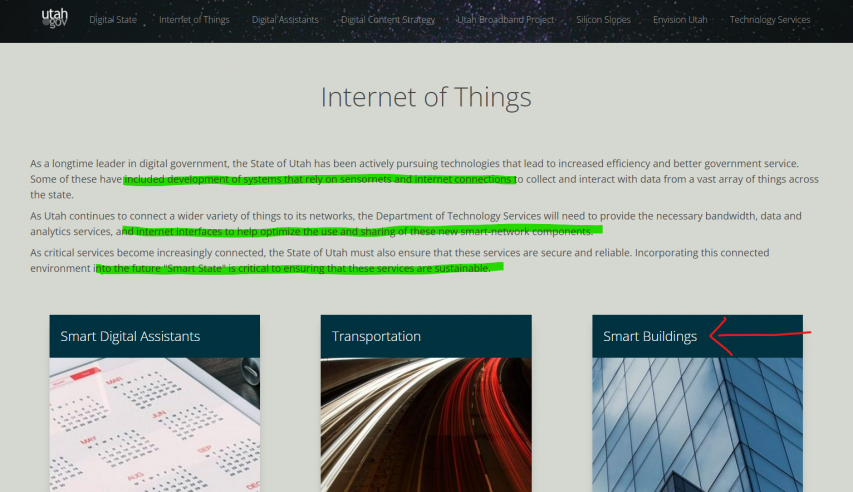
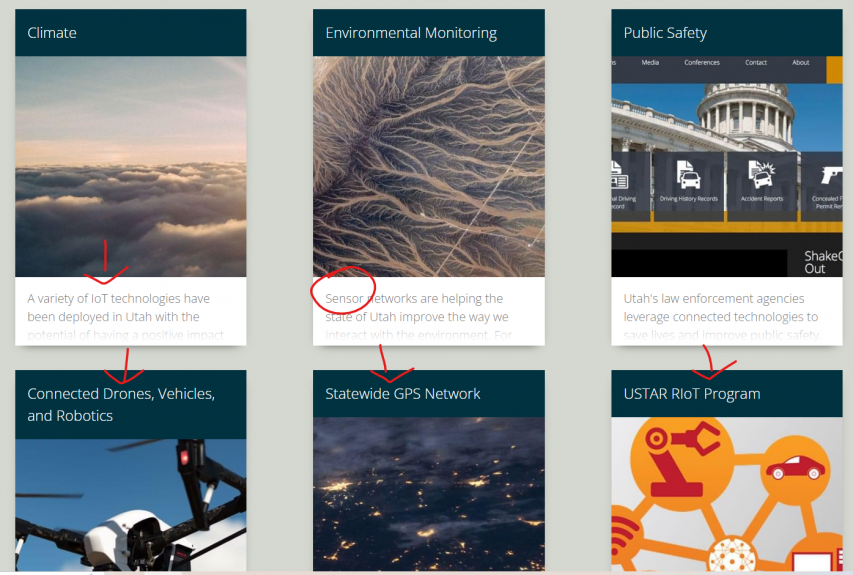
The obvious first thing I noticed was that we do indeed have “smart buildings” and lights. Make sure to check out Salt Lake Cities changes to your streetlights for the full breakdown on lighting. Below are some screenshots from the document. Notice the list of surveillance systems: cameras, air quality sensors, smart parking, speakers (can they record your conversations as well?), EV, noise monitoring and more.
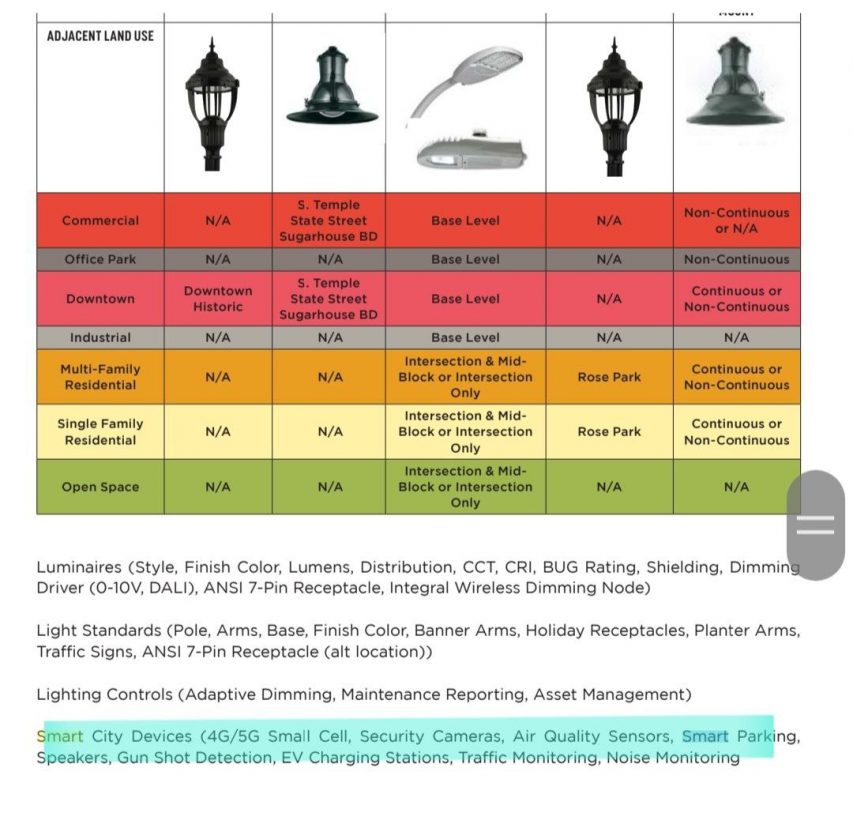
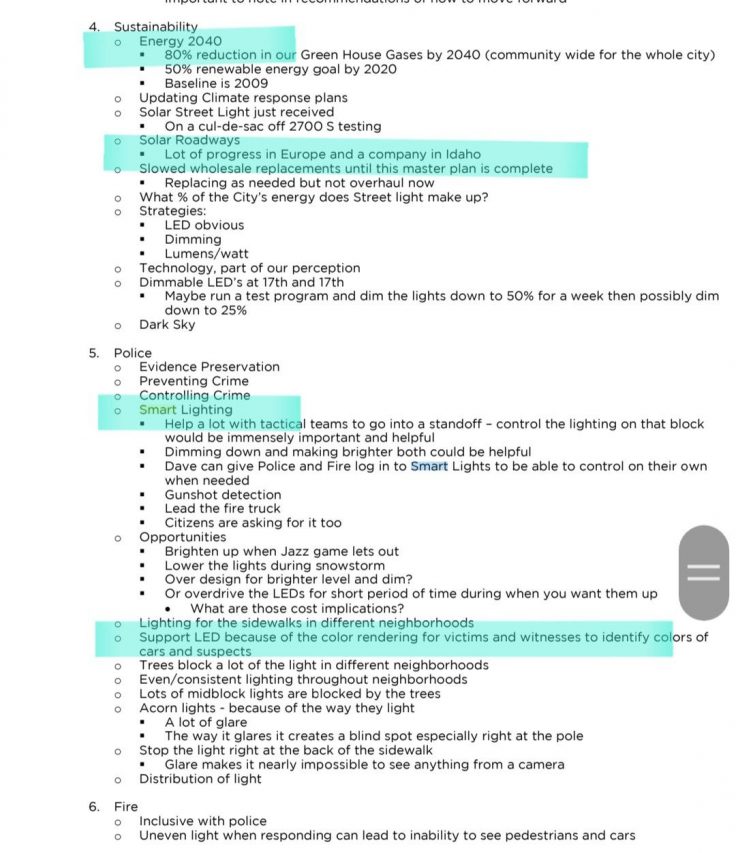
This is a small sample of lighting planned for a city/county. Each city and county have masterplans that are multiple pages . Many include invasive surveillance and IoT installations yet to be implemented.
“Enhancing mobile citizen engagement and delivery of government services.”
What in the world does “mobile citizen engagement and delivery of government services” mean? Well, who better than the “World Bank” to tell us, or show us?
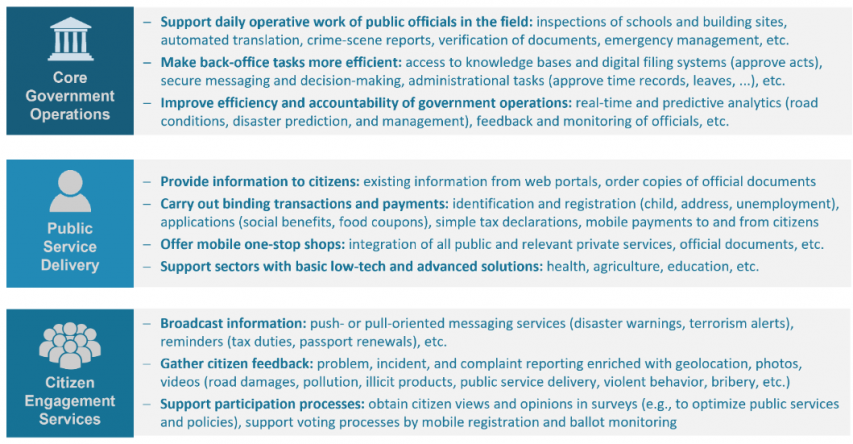
Now let’s see what Utah says. The below definition is pulled right from Utah.gov:
IoT and government: “Today’s smartphones, tablets, and other smart wearable devices provide the user with a growing array of useful services. For example, ontime.utah.gov provides the user with real-time information about nearby bus stops, Trax and Frontrunner schedules, etc. based on location information. Utah.gov provides the same user with information about public meetings in the local area or nearby parks, schools and government offices, as well as job opportunities.”
Local Government Collaboration and Smart Cities: This one oddly doesn’t have a paragraph like all the other sections, but it does have a title and image that are very telling.
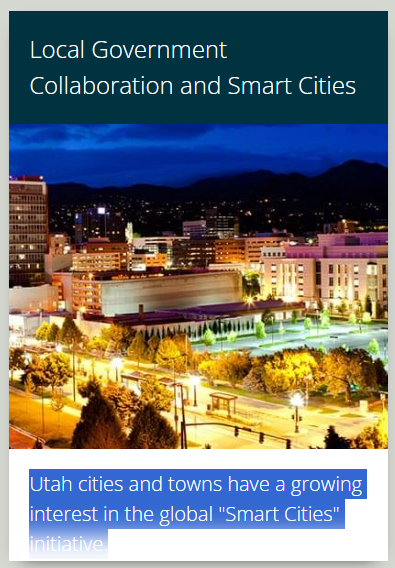
Now what stands out to me here is, “Utah cities and towns have a growing interest in the GLOBAL “Smart Cities” initiative”. Is that true? In all the whispers and rumblings are you hearing the cities and towns’ interest growing? Possibly. Is it positive or negative? In my runs to the grocery store, church, or community events I have only heard concern and anger. The discussions seem to fall on Utah City and The Point, neither being spoken of positively.
The people I speak with, who range from business owners, city and county council members to us, the regular people, all express their growing frustration with not being heard by our “elected representatives” regarding development.
In a fortuitous turn of events Governor Cox surprising and shockingly stated in a PBS speech that he and the League of Cities and Towns have taken steps to remove the ability of the public, in various degrees, to referendum and/or change laws they (THE PEOPLE) view as bad. It doesn’t stop there. Not only have they openly and proudly made the public’s opinion almost null and void, but they have made it so your representative government (city and county councils) have been dealt a blow as well. You can watch the clip below:
Now how does this tie in with “smart Utah?” How many of you know about HB470 that was passed this session? This bill took Utah into not only a leadership role but a dangerous one in my opinion. So what exactly did this bill do? Well below is a quote from statescoop.com
“The bill, HB 470, requires the agency to provide recommendations to government entities on how to issue a digital ID or other record through distributed-ledger technology.”
As you can imagine this will be used for much more than digital ID. It will be used to convert the government into e-governance or digital government. This of course is a core piece of a smart state, as mentioned in the Smart Cities Council list.
This bill in particular and others that go along with it from this year and last, aid in the next item on the list:
“Developing a procurement platform to obtain better pricing through volume discounts and streamline city and state purchasing.”
The ledger will likely be used for all government services, including a procurement platform. This way they can use smart contracts. If you want more information on what “smart contracts” are this is a brief easy to understand rundown.
So, this brings us to one of the more obtuse points:
“Generating more benefits from the existing portfolio of state assets”
That sounds lovely right? We all want more benefits from the existing portfolio of state assets, whatever that means. Well let’s dig into that a bit.
If you think it means what Deloitte implies then it’s all about Public Private Partnerships (PPPs).
“As cities look to upgrade their infrastructure with smart technologies, paying for those projects presents a significant challenge of introducing smart technologies on a wide-scale basis. Constrained by tight budgets, cities need to identify business models that can help to attract private financing in order to make the introduction viable and financeable.”
– The challenge of paying for smart cities projects
Or you can go with the not as direct definition from McKinsey Global Institute founded in 1990 (that timeline will tie in later in my series)
“Cities are home to more than half of the world’s population, and they are expected to add another 2.5 billion new residents by 2050. They face increasing environmental pressures and infrastructure needs—and growing demands from residents to deliver a better quality of life and to do so at a sustainable cost. Smart technologies can help cities meet these challenges, and they are already enabling the next wave of public investment. It all starts with data. Cities, in all their complexity and scope, generate oceans of it. Finding the insights in all that data helps municipal governments respond to fluid situations, allocate resources wisely, and plan for the future. Furthermore, putting real-time information into the hands of individuals and companies empowers them to make better decisions and play a more active role in shaping the city’s overall performance. As cities get smarter, they become more livable and more responsive—and today we are seeing only a glimpse of what technology could eventually do in the urban environment”
– SMART CITIES: DIGITAL SOLUTIONS FOR A MORE LIVABLE FUTURE
Or, maybe it comes across as something different and even positive to you?
Utah is neck deep in PPPs. This is against the Utah constitution – learn more here. In Utah we have an organization know as P3+ “We are Utah’s single point of contact for public-private partnerships.” Per P3+ they layout their program as below:
“In 2020, Utah’s Legislature passed Senate Bill 133 to promote public-private partnerships. The cornerstone of this legislation was the creation of a facilitator to serve as the state’s single point of contact and source of information for public-private partnerships (P3s or PPPs) in Utah. The legislation directed the Governor’s Office of Economic Opportunity (GOEO) to select a facilitator using a competitive bidding process. In November 2020, GOEO selected P3+ to serve as the state’s facilitator.”
This leads us to what is, in my opinion, the most alarming item on the list:
“Creating a more business-friendly state supported by a digital portal.”
Again, this sounds simple and if we’re going all digital then it is needed, right? Well, you, us, we, need to ask if we want an entirely digital government and ALL our records eventually in one place? All the surveillance issues aside, and there are a LOT, let’s just ask about security from ALL our data falling into the “bad guys” hands. Don’t worry they will tell you blockchain is secure and can’t be hacked, especially if they have “decentralized” nodes/ledgers. Without going off into those weeds we will just say someone has access aside from you and that is the government. Are they trustworthy?
With that out of the way let’s get into Utah’s digital “citizen portal.” There are many concerning items on this website but let’s focus on their “vision.”
Vision:
A single login with secure multi-factor authentication
A unique ID and way to verify identity
A single web page for an individual to do a number of different functions
Ways for individuals to avoid having to go into offices
Unified mobile friendly experience with accessibility, consistent navigation, security
As you can see, we have identity being pushed under the less scary name “unique ID and way to verify identity.” This is digital, of course, so what is that then? A digital ID? Sure, looks like it.
But the kicker is “ways for individuals to avoid having to go into offices.” What do you think that looks like? These smart states/cities/governments, are removing human interaction. They are removing accessibility. How many times have you gone through an automated system and have nearly thrown the phone across the room trying to get to a person? Imagine a world where that simply is no longer an option, there is no person to contact? That is where this is heading. To make my point very clear let’s look at documents from Utah that they didn’t show you the public in their advertisements.
The first screenshots are from 2021. Some things to point out below:
- Why are they creating user personas? Motivations and personality? That is very invasive and furthermore why does the government (not a business supposedly) want or need access to this information? Where do they get the details for this? A social credit score system? Monitoring our social media? Some questions to ask.
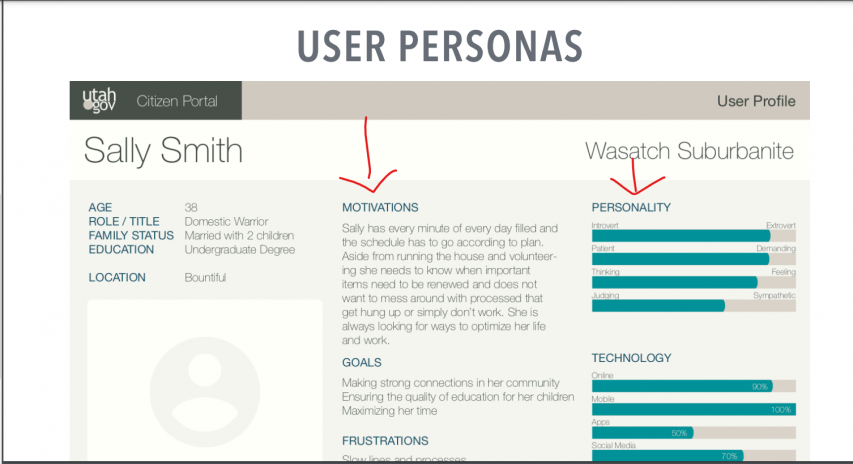
2. Here we go again with the digital ID that they are trying to call anything else but that. The reason I highlighted tax filing is to remind you all about what the plan was last year for tax filings that the federal government (IRS) had to backtrack on. Biometrics were going to be required to file. Do you think that could happen with this? Are we centralizing all of our information into one government system?
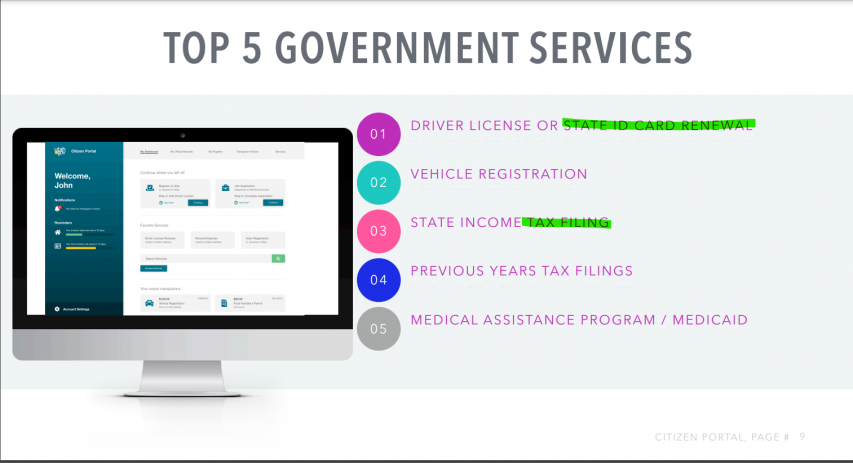
3. Digital Wallet, oh boy, we know where this is going, right? The central bank digital currency (CBDC). On this point, I will express my opinion. This is the deal breaker. Without control over our own money, we (The PEOPLE) are in BIG TROUBLE. This one absolutely cannot go through. Unfortunately, Utah is a sitting duck because they passed laws to allow this monster to take over.
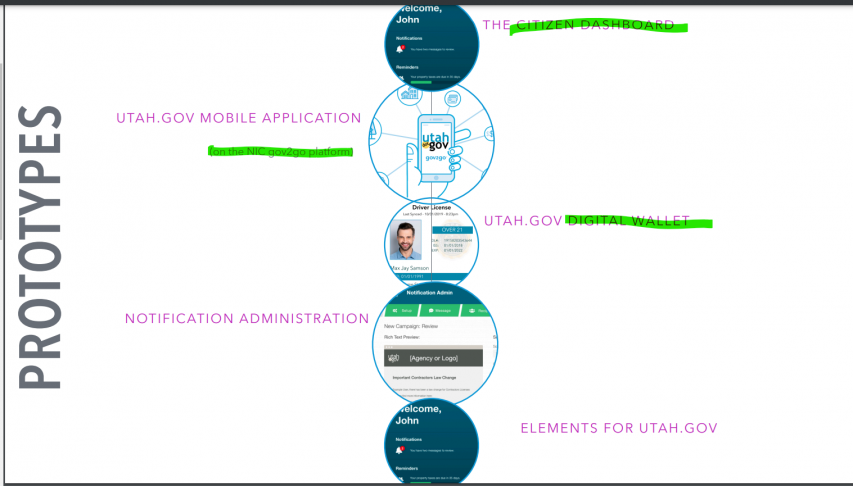
Now we will show the current presentation for the “citizen portal.” They have made a lot of progress and have a timeline. Below are some key points from the new presentation to make note of.
- “Contactless” – as we said earlier, imagine a world where you have no access to those making the rules that you are forced to comply with? Imagine if there is an error with your “social credit score” and you can’t reach a human to address it? Imagine voting for people who are never there? Don’t worry in this clip Klaus Schwab is talking about prescriptive AI replacing voting, so you won’t be doing much voting in the future.
- Also in this shot is the mention of “current digital government is less efficient because it focuses on individual transactions versus a holistic view.” Let’s unpack what is really being said here. First, notice the removal of individual into “holistic” which in the social and health world is tied to “whole person care” – go down that rabbit hole on another day. This is collective communism lingo wrapped in pretty and not scary words. ALL of your data will be in one place, there will be no privacy.

- Here we go again- third time if you’re counting referencing a digital ID under a less scary name. One Utah, for those that don’t know, is centralized government much like communism. They have tried to cloak it a bit by having “One Utah Health Collaborative,” and “One water,” and almost all other departments you can imagine, but it all rolls up to “One Utah.” So much so that it has its own building titled “One Utah Center.”
- Mobile first strategy means you WILL HAVE to always carry a “smart phone” (surveillance) to access anything and everything. Is this a world you want for your children?

- This is all due and required to be created by January 1, 2025. While it’s not stated here, this means YOU, ME, US, WE will all be REQUIRED to have digital ID.
- Look at the money going into this? $29 million! Wonder who got the contract for this big project? (we will give details on that later in my series)

- Smart Speakers – who doesn’t want those? How have we lived thus far without it? At some point we as Americans must start to face the reality of what “convenience” is costing us. Something to pay attention to here and the next item is “Alexa” (Amazon) being promoted. Why is the government using a 3rd party system? Is this a public-private partnership or is it a non-governmental organization agreement? Defending Utah would love to hear your thoughts.
- Fourth time now for digital ID. Did you get the message that they want digital ID at all costs? I sure did.
- Mobile Transactions “speech enabled” car. Look at who they’re working with again. Amazon, Apple, Tesla, and Google. What a bunch of free speech fighters right there. This is extremely dangerous. Does this breach the 4th amendment? I think so. What do you think?

Okay, I think we’ve hit home on the “citizen portal” item. Now, we will move to the next.
“Applying smart cities standards”
Now, there are a few versions of this as well so we will be highlighting BSIGroups version first.
“As City Authorities and their delivery partners strive to meet aspirations of citizens, they face complex choices and decisions about what type of City they are seeking to create. Different Cities will have different visions or priorities for development, reflecting the needs and circumstances of their populations and economic activities. At the same time, they face common challenges around maintaining economic growth and meeting the needs of increasing or aging populations while reducing use of resources.
- Maintaining economic growth: Cities – nationally and internationally – are main drivers of economic activity: growth and, in the current context, recovery. This output depends on a comprehensive infrastructure to deliver physical and social resources – the fuel of a City’s ‘economic engine’. The economic performance of a City is inextricably linked to its physical and communications infrastructures, and the delivery of resources through these infrastructures.
- Increasing populations: Cities occupy only around 2% of land mass and are occupied by 51% of the world’s population and they consume an estimated 80% of its resources. The current global population is 7+ billion, and is forecast to grow to 9+ billion by 2050, by which time it has been predicted that approximately 80% of the global population will be urbanised.
- Resource usage: Cities are under pressure to reduce resources, both in terms of the amount of money they spend on delivering services and the carbon footprint across the city. The strain on traditional delivery mechanisms and supply of resources due to increasing populations poses a significant challenge to the sustainable growth of Cities. This applies not only to physical resources, such as energy, water or waste management, but also to social and economic resources, such as healthcare, traffic management and City logistics.”
And here is another view, similar but with a slightly different take.
“Smart cities employ technology and data to increase efficiencies, economic development, sustainability, and life quality for citizens in urban areas. Inevitably, clean technologies promote smart cities development including for energy, transportation and health. The smart city concept is ambitious and is being refined with standards. Standards are used to help with regulating how smart cities function and contributing to define a smart city. Smart cities must be officially recognized by national and international authorities and organizations in order to promote societal advancement.”
– A Review of Technical Standards for Smart Cities
Without getting in too deep here we are nearly 100% sure you have been beaten over the head with the panic about Utah’s population growing. Well, Envision Utah has been saying the same thing since 1997. It’s always going to grow by 1 million, until they were called out by another group and then it suddenly changed to 2 million. Utah Freedom Coalition said it was okay if I took their screenshot for this article. “Today” being referenced is August 4th, 2023.
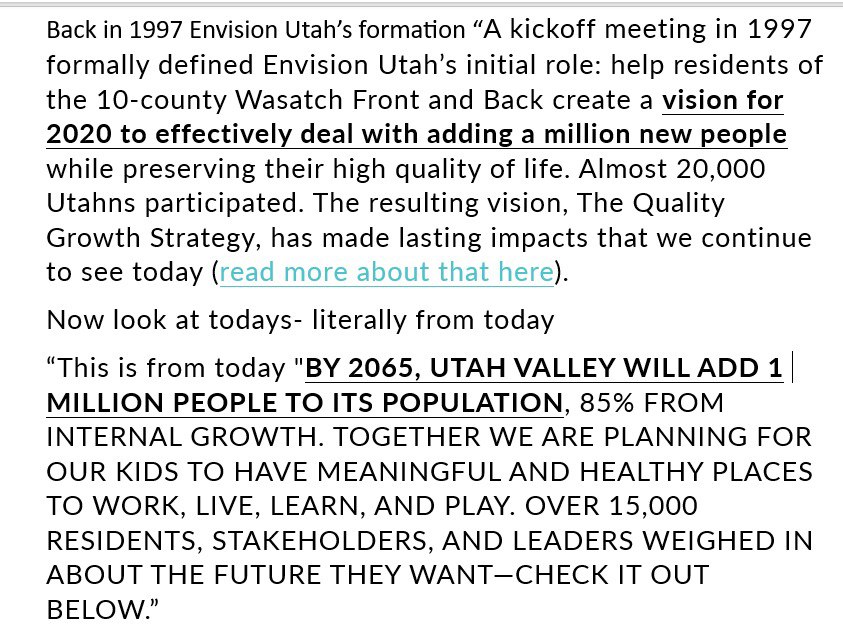
Source: https://envisionutah.org/valley-visioning and https://envisionutah.org/our-process
And Envision Utah Smart Growth
We also don’t need to beat you over the head with the “water conservation” campaign Utah has been pushing, so we will simply post some references here for verification.
Utah water conservation website
Utah energy conservation website
Utah waste management website – this website needs a deep dive, but it’s fairly disturbing in its connections to the United Nations SDG goals.
Now the kicker to all of this is what? SMART EVERYTHING.
Utah smart energy meters and wattsmart
Utah Ignite– the smart city infrastructure.
Is Utah getting recognition from global and the “elite”? Let’s look:
The World Economic Forum giving Utah props for our “walkable” cities.
15 min cities the future of Utah development
Utah is building a 15 min city– from the UK
Vineyard Utah City (smart city) using TIF tool for housing near transit
Almost done, moving to the 2nd to last item on the list:
“Reviewing policy and regulations to remove barriers to implementing smart technologies.”
We don’t need to spend much time here as you can see from what we have shared the guardrails have been ripped right off and we are in a free fall to a very scary, digitally controlled, and I would say, totalitarian future. Let us know what you think.
Last, but certainly not least:
“Establishing a Smart Illinois brand” (Utah in this case)
This will lead into a major revelation, but Utah definitely has branded Smart – it’s called “SmartUtah,” or it was when our former Governor Leavitt used the term in 1994 to push his “SMART” agenda on the rest of the country.
Coming in part 3… we will start to dig into the timeline of how, when and who. It will be quite enlightening.
Upcoming Solutions
The Utah Central Committee of Rights has prepared a document to help cities and counties nullify surveillance that is forced up on them by the federal government or the state of Utah (or any 3rd party) and people should get familiar with these rights that have been laid out for local communities.
[2023-5] Right to Privacy, Nullification of Unconstitutional Government Surveillance

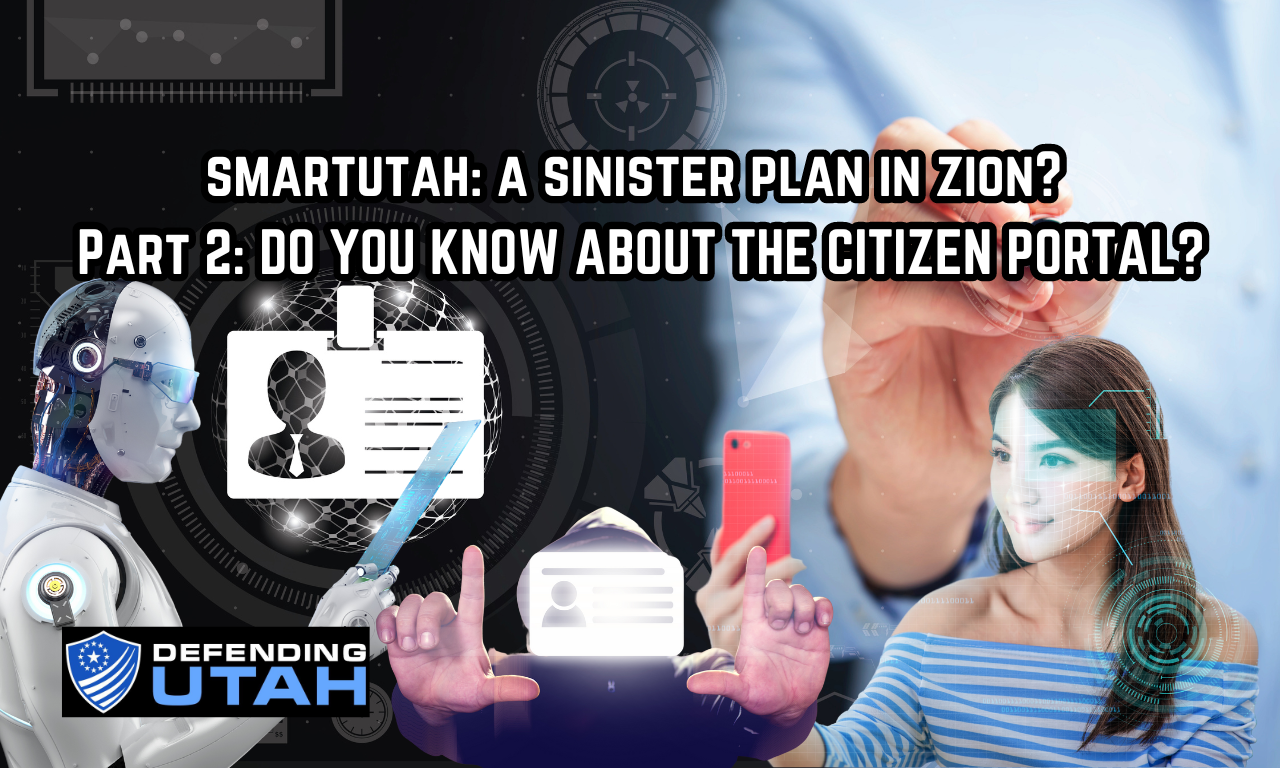
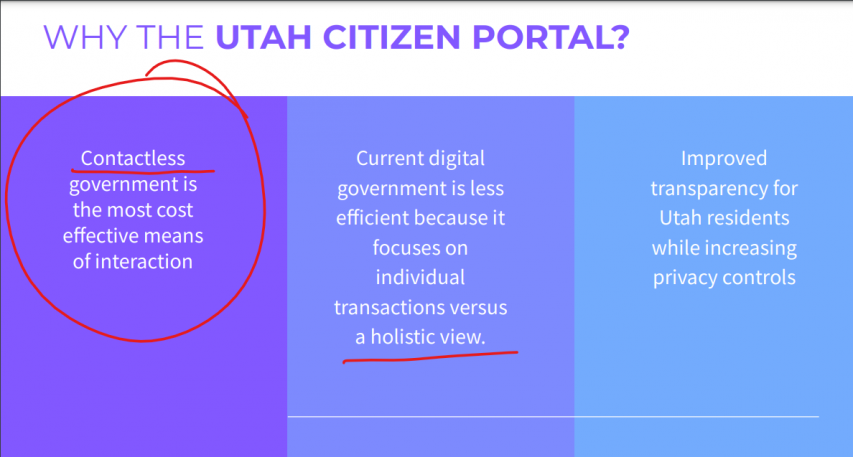
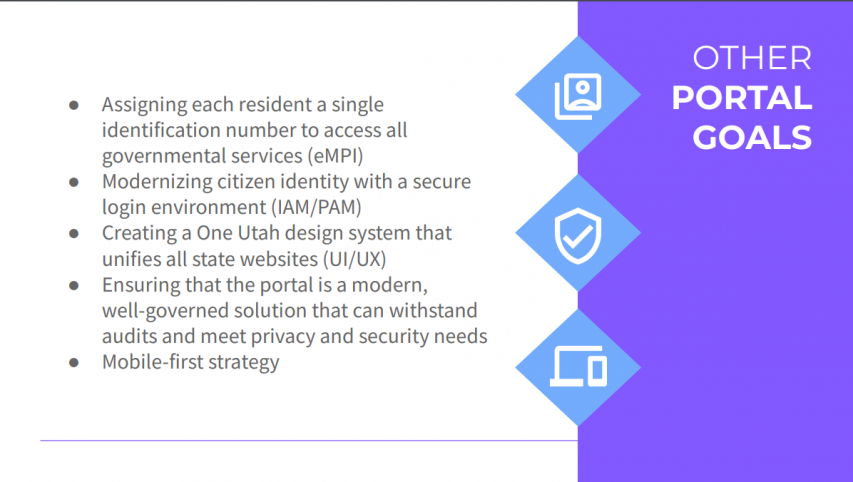
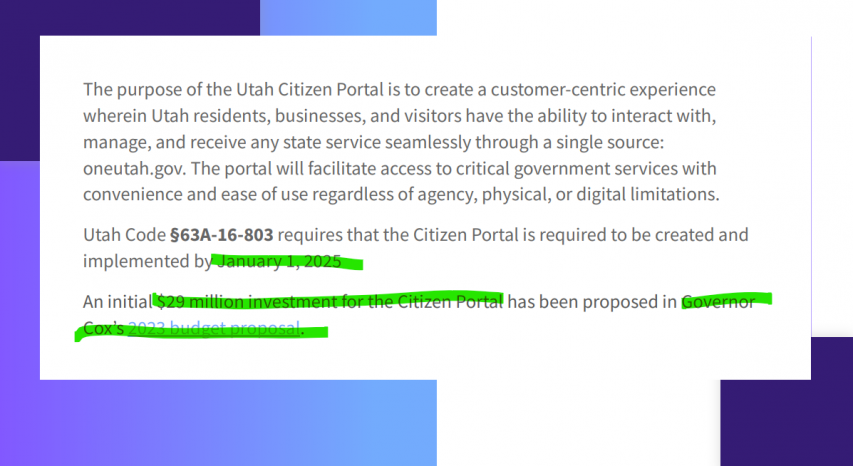
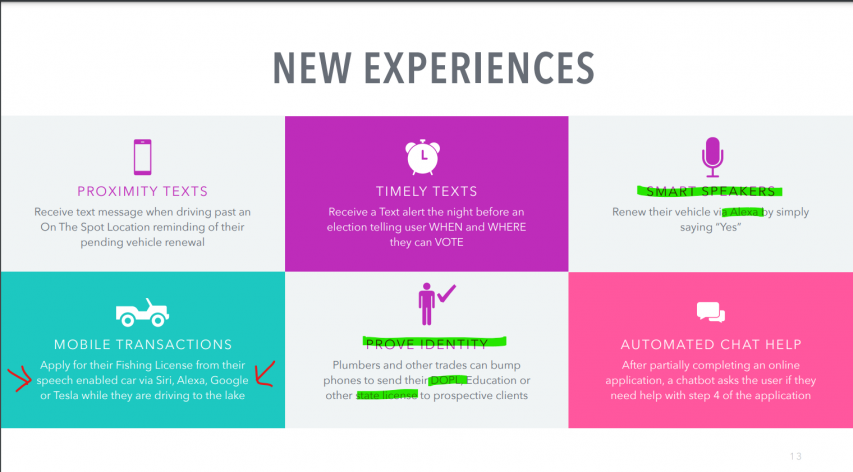
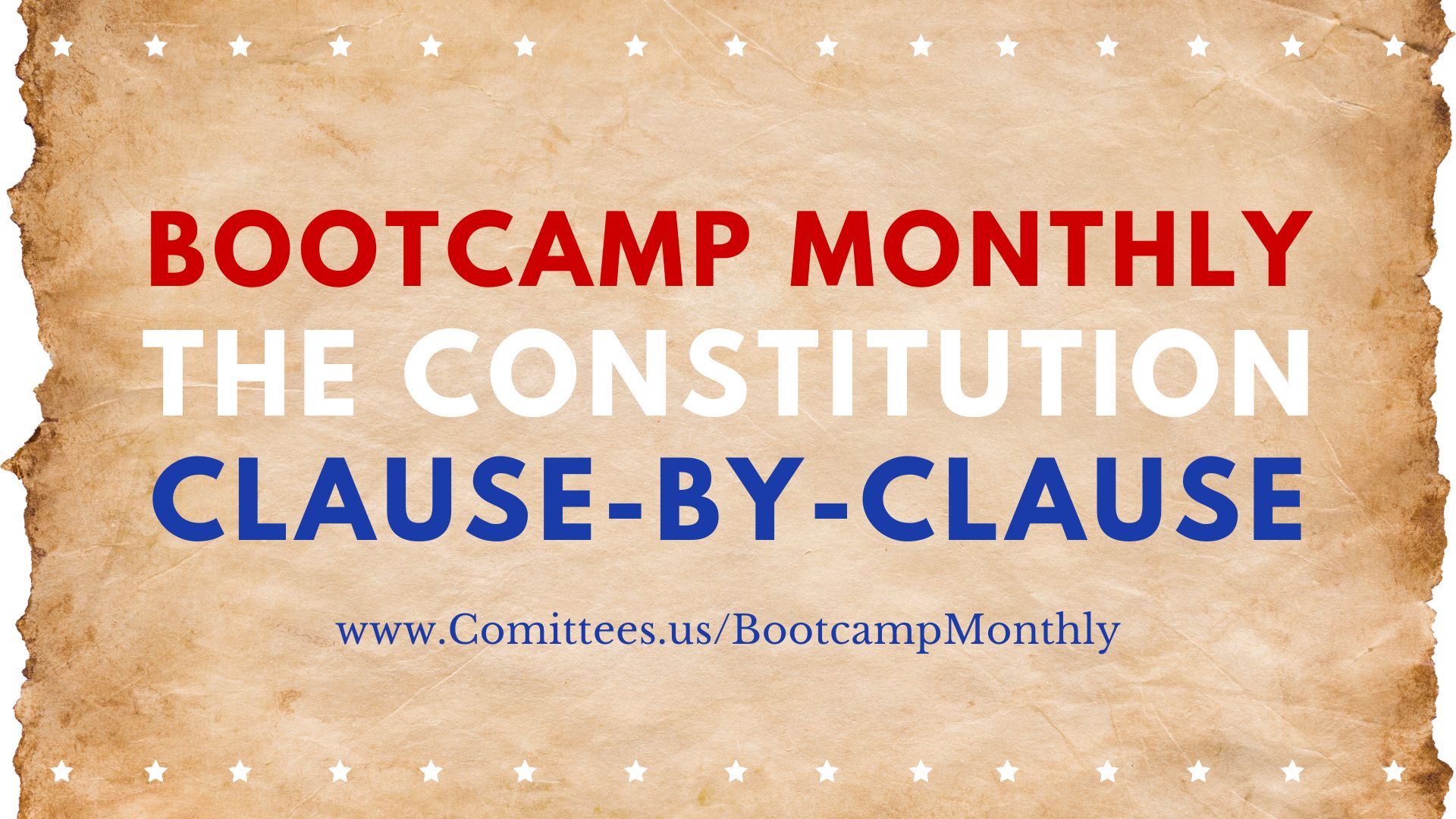
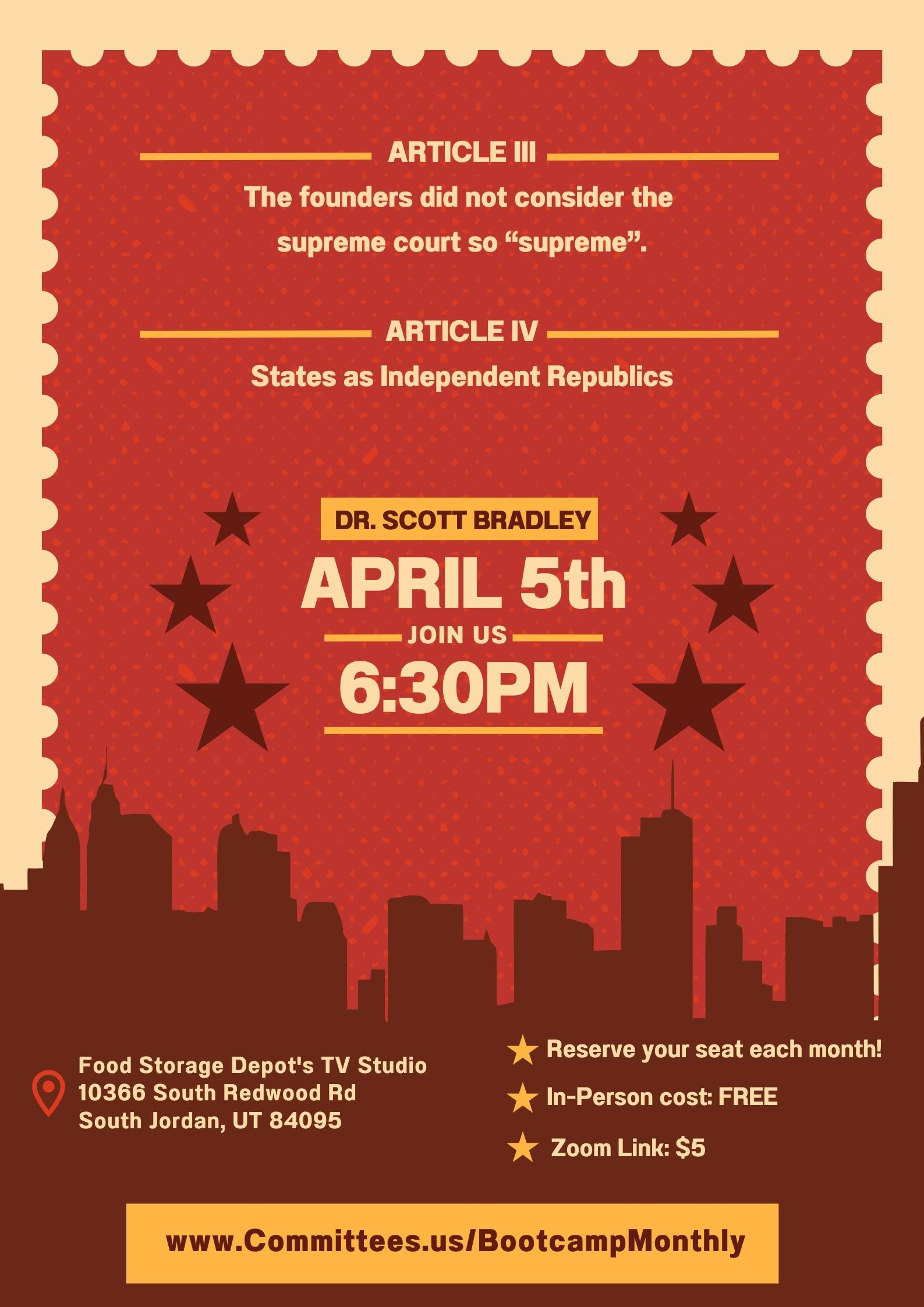






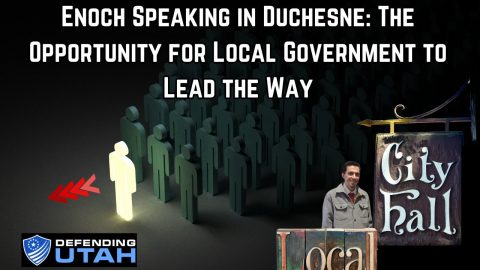
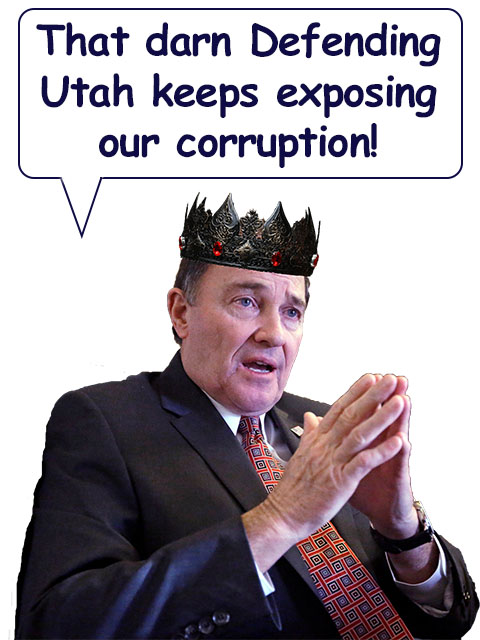
One Response
Imagine if it became common knowledge that non-ionizing radiation at the amounts emanating from cell phones, Wi-Fi, cell towers, and other wireless technologies is carcinogenic. The agenda basically relies on people not being aware of this.